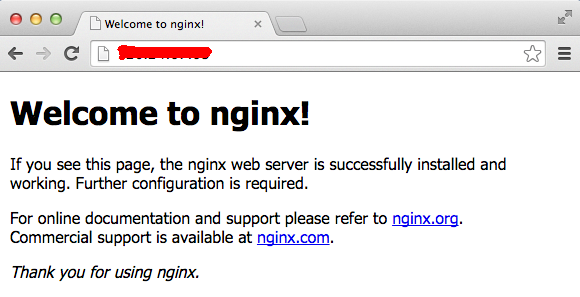注:以下所有操作均在CentOS 6.5 x86_64位系统下完成。
#准备工作#
在安装Nginx之前,请确保已经使用yum安装了pcre等基础组件,具体见《CentOS安装LNMP环境的基础组件》。
然后创建www的用户组和用户,并且不允许登录权限:
# id www id: www:无此用户 # groupadd www # useradd -g www -s /sbin/nologin www # id www uid=501(www) gid=501(www) 组=501(www)
#Nginx的安装#
开始下载Nginx并进行编译安装:
# cd /usr/local/src # wget http://nginx.org/download/nginx-1.6.2.tar.gz # tar zxf nginx-1.6.2.tar.gz # cd nginx-1.6.2 # ./configure --prefix=/usr/local/nginx-1.6.2 --group=www --user=www --with-http_ssl_module --with-pcre --with-http_stub_status_module --with-http_gzip_static_module Configuration summary + using system PCRE library + using system OpenSSL library + md5: using OpenSSL library + sha1: using OpenSSL library + using system zlib library nginx path prefix: "/usr/local/nginx-1.6.2" nginx binary file: "/usr/local/nginx-1.6.2/sbin/nginx" nginx configuration prefix: "/usr/local/nginx-1.6.2/conf" nginx configuration file: "/usr/local/nginx-1.6.2/conf/nginx.conf" nginx pid file: "/usr/local/nginx-1.6.2/logs/nginx.pid" nginx error log file: "/usr/local/nginx-1.6.2/logs/error.log" nginx http access log file: "/usr/local/nginx-1.6.2/logs/access.log" nginx http client request body temporary files: "client_body_temp" nginx http proxy temporary files: "proxy_temp" nginx http fastcgi temporary files: "fastcgi_temp" nginx http uwsgi temporary files: "uwsgi_temp" nginx http scgi temporary files: "scgi_temp" # make && make install # ln -s /usr/local/nginx-1.6.2/ /usr/local/nginx # chown -R www:www /usr/local/nginx # chown -R www:www /usr/local/nginx-1.6.2
把Nginx的sbin目录加入PATH:
# vim /etc/profile export PATH=$PATH:/usr/local/mysql/bin:$JAVA_HOME/bin:/usr/local/nginx/sbin # source /etc/profile
查看Nginx的版本信息,并且检验上一步骤是否成功:
# nginx -V nginx version: nginx/1.6.2 built by gcc 4.4.7 20120313 (Red Hat 4.4.7-4) (GCC) TLS SNI support enabled configure arguments: --prefix=/usr/local/nginx-1.6.2 --group=www --user=www --with-http_ssl_module --with-pcre --with-http_stub_status_module
至此,Nginx已经安装完毕。
#Nginx的启动/重启/关闭#
给Nginx的webapp配置相关路径(这里是为了后面运维管理方便,可以把不同的Web项目放到该目录下):
# mkdir -p /data/www
简单修改下配置文件:
# vim /usr/local/nginx/conf/nginx.conf user www; worker_processes 1; events { worker_connections 1024; } http { include mime.types; default_type application/octet-stream; sendfile on; keepalive_timeout 65; gzip on; server { listen 80; server_name localhost; location / { root html; index index.html index.htm; } } }
开始启动Nginx:
# nginx
这个时候打开浏览器访问地址http://youripaddress应该可以看到:

至此,Nginx已经启动成功。
一般来说,当修改了nginx.conf配置文件后,可以直接重启让配置生效,重启之前一般检测下配置文件是否正确:
# nginx -t nginx: the configuration file /usr/local/nginx-1.6.2/conf/nginx.conf syntax is ok nginx: configuration file /usr/local/nginx-1.6.2/conf/nginx.conf test is successful # nginx -s reload
另外,重启也可以通过发信号的方式:
# kill -HUP ${master_pid}
关闭的命令如下:
# nginx -s quit
# nginx -s stop
注:quit表示等请求结束后再关闭,stop表示立刻关闭。
也可以通过发信号的方式来关闭:
# kill -QUIT ${nginx_master} # kill -TERM ${nginx_master} # kill -9 ${nginx_master}
注:-QUIT表示从容停止,等所有请求结束后再关闭进程;TERM则表示立刻关闭进程;-9表示强制关闭。
为了以后管理上的方便, 我们这里写个启动脚本,以后就可以用service命令来启动,如下:
# vim /etc/init.d/nginxd #!/bin/sh # chkconfig: 2345 85 15 # description:Nginx Server NGINX_HOME=/usr/local/nginx-1.6.2 NGINX_SBIN=$NGINX_HOME/sbin/nginx NGINX_CONF=$NGINX_HOME/conf/nginx.conf NGINX_PID=$NGINX_HOME/logs/nginx.pid NGINX_NAME="Nginx" . /etc/rc.d/init.d/functions if [ ! -f $NGINX_SBIN ] then echo "$NGINX_NAME startup: $NGINX_SBIN not exists! " exit fi start() { $NGINX_SBIN -c $NGINX_CONF ret=$? if [ $ret -eq 0 ]; then action $"Starting $NGINX_NAME: " /bin/true else action $"Starting $NGINX_NAME: " /bin/false fi } stop() { kill `cat $NGINX_PID` ret=$? if [ $ret -eq 0 ]; then action $"Stopping $NGINX_NAME: " /bin/true else action $"Stopping $NGINX_NAME: " /bin/false fi } restart() { stop start } check() { $NGINX_SBIN -c $NGINX_CONF -t } reload() { kill -HUP `cat $NGINX_PID` && echo "reload success!" } relog() { kill -USR1 `cat $NGINX_PID` && echo "relog success!" } case "$1" in start) start ;; stop) stop ;; restart) restart ;; check|chk) check ;; status) status -p $NGINX_PID ;; reload) reload ;; relog) relog ;; *) echo $"Usage: $0 {start|stop|restart|reload|status|check|relog}" exit 1 esac # chmod +x /etc/init.d/nginxd # chkconfig nginxd on
这样子就可以通过service来启动:
# service nginxd start
#Nginx的安全配置#
1、 首先设置不允许目录浏览,默认配置即为不允许。
autoindex off
2、开启访问日志,nginx中默认已开启,这里我们后续为了运维管理上的方便最好把日志单独放到/data目录下。
access_log /data/www/logs/localhost.access.log
3、确保目录的安全,由于Nginx使用的是www用户启动,黑客入侵服务器成功后将获得www用户的权限,所以需要确保网站Web目录和文件的属主与启动用户不同,防止网站被黑客恶意篡改和删除。网站Web目录和文件的属主可以设置为root,其中Web目录权限统一设置为755,Web文件权限统一设置为644。只有上传目录等可读写权限的目录可以被设置为777,为了防止黑客上传木马到777权限目录中,还必须保证该777权限的目录没有执行脚本的权限。这里有两种情况处理:
1)对于使用PHP的业务,配置如下:
location ~* ^/data/www/logs/.*\.(php|php5)$ {
deny all;
}
注:当然最安全的还是给PHP的可执行目录采用白名单的方式,这个我们在PHP的安装一节中再详细介绍。
2)对于非使用PHP的业务(如python、cgi等),则需要禁止外部访问777目录,配置如下:
location ~ ^/data/www/logs/ {
deny all;
}
4、对于管理目录,需要限制访问的IP地址,比如这里限制访问nginx状态的:
server { location /nginx-admin { stub_status on; access_log logs/nginx-admin.log; allow 11.12.23.0/24; deny all; } location /admin { ... } }
注:上面配置的11.12.23.0/24指的就是当前运维客户端的IP地址段。
在允许IP的机器上输入地址应该可以看到:

而不允许的用户访问应该是不可以的,会显示403错误,比如:

5、把Nginx默认的首页等页面删除,使用业务自己的首页来顶替。
6、不允许IP直接访问服务器,这样的好处是怕当IP地址泄漏出去之后,被人用别的域名来指向了这个IP地址,可以设置让其返回500等错误码。比如:
server { listen 80 default; return 500; } server { listen 80; server_name www.tencent.com tencent.com; root /data/www/tencent; access_log /data/logs/nginx/tencent.access.log; error_log /data/logs/nginx/tencent.error.log; }
注:上面的配置表示当使用IP地址直接访问时将出错,而使用域名访问时(比如请求tencent.com则正常)。
#Nginx的性能配置#
1、使用epoll的I/O模型,一般为默认。
use epoll;
2、 配置Nginx的进程数,一般根据CPU的数目来设置,比如双核的可以配置为2或4。
work_processes 4;
3、配置每个进程允许的最大连接数,理论上每台Nginx服务器的最大连接数为work_processes*worker_connections,需要根据当前服务器配置进行设置。
worker_connections 10240;
4、配置Nginx进程打开的最多文件描述符数目,最好与系统的ulimit -n保持一致。
worker_rlimit_nofile 102400;
5、配置keepalive超时时间,默认以秒为单位。
keepalive_timeout 60;
6、配置客户端请求头部的缓冲区大小,这个可以根据系统分页大小来设置,分页大小可以用命令getconf PAGESIZE来获取。
client_header_buffer_size 4k;
7、配置为打开文件指定缓存(默认没有启用),建议和打开文件数一致,并且为其指定缓存过期时间。
open_file_cache max=102400 inactive=20s;
8、配置缓存的有效信息检查时间间隔。
open_file_cache_valid 30s;
9、配置在缓存过期时间内文件的最少使用次数,如果低于这个次数则将缓存移除。
open_file_cache_min_uses 1;